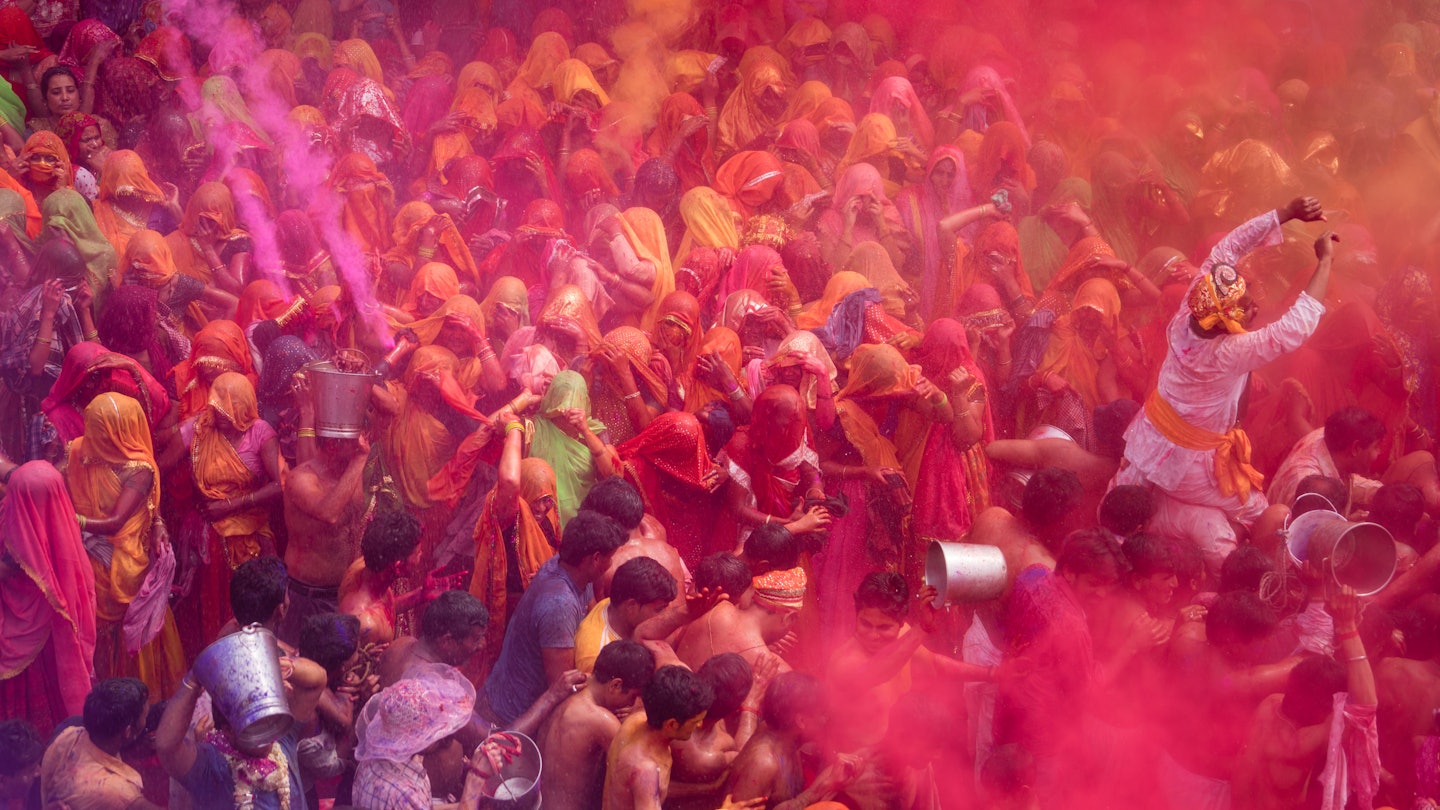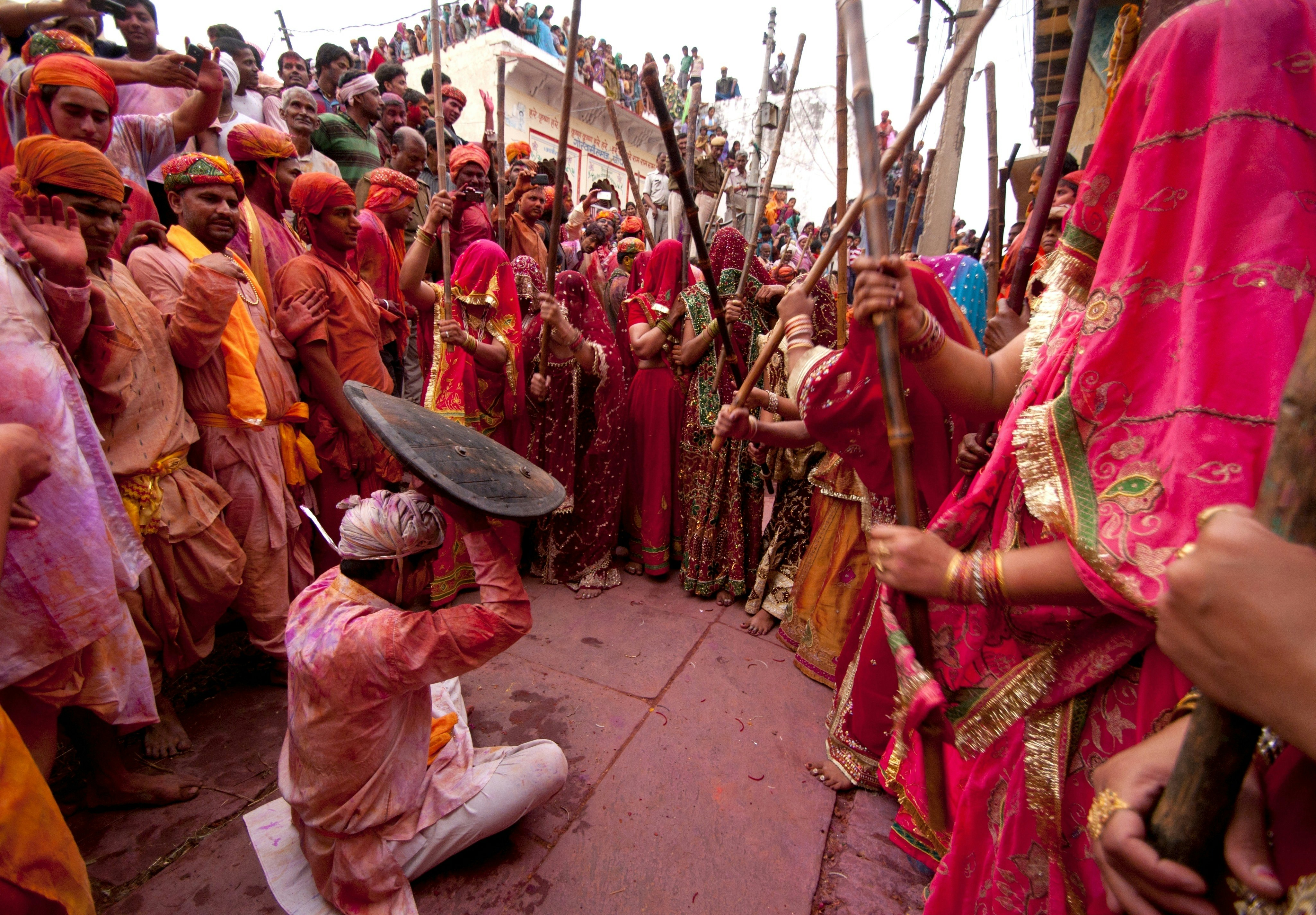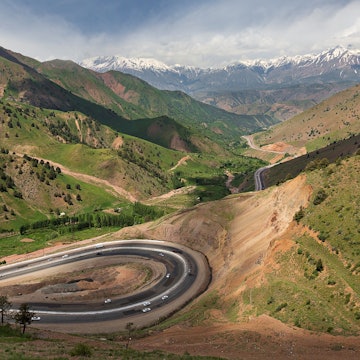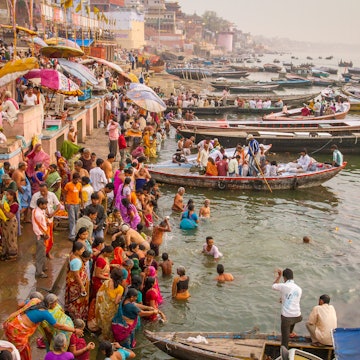

Holi is one of India's most spectacular festivals. Nigel Killeen/Getty Images
As winter wanes, India gets ready to welcome spring and the onset of the harvest season, heralded by the spectacular festival of Holi.
This vividly colorful Hindu festival is celebrated with fanfare across the country, with the burning of bonfires and millions of people splashing each other with gulal (colored powder). In fact, in many parts of northern India, Holi is celebrated on a grander scale than even Diwali.
While the dates change every year, following the Hindu lunar calendar, Holi usually falls in March, which is a great time to visit India and dive headlong into its most vibrant and colorful festival. If you want to join in the celebrations, here's what you need to know about Holi.

What is Holi and how is it celebrated?
Often referred to as the "Festival of Colors," Holi is a vibrant and joyous Hindu festival celebrated across India, and by Indian communities worldwide. It falls on the full moon day of the Hindu month of Phalguna, which usually falls in March in the Gregorian calendar, and marks the triumph of good over evil.
As with most Indian festivals, the origins of Holi are linked to ancient legends. According to the Hindu texts known as the Puranas, the demoness Holika tried to murder her nephew, Prahlada, in a funeral pyre. Through the power of his devotion to Lord Vishnu, Prahlada was saved from the flames, and it was Holika who came to a fiery end instead – a classic story of good vanquishing evil.
Bonfires are a common feature of Holi celebrations across the country. A few days before the festival, people start collecting wood, twigs and other combustible materials for the ritual bonfires. The night before Holi, the bonfires are lit in a ritual called Holika Dahan or Chhoti Holi, symbolizing the burning of negativity and evil.
The main celebration occurs the next day, which is variously called Rangwali Holi, Ranga Panchami, Dhulandi, Phagwah or Badi Holi. People of all ages get together, smearing each other with colored powders and drenching one another with water balloons and colored water.
According to legend, the ritual of throwing colored powder was started by Krishna (an incarnation of Vishnu) in the meadows of Vrindavan, between Delhi and Agra. Traditional songs and dances add to the revelry, and friends and family visit each other to exchange festive sweets and good wishes.

Where are the best places to celebrate Holi in India?
Holi celebrations and rituals vary across India and the best place to take in the festival will depend on the kind of experience you want to have. The most colorful Holi celebrations take place in the temple towns of Mathura and Vrindavan in Uttar Pradesh – Mathura is where Lord Krishna was born, while Vrindavan was where he spent his childhood.
The week-long celebrations at the Banke Bihari Temple in Vrindavan are legendary, beginning with Phoolon Wali Holi (the throwing of flowers) and ending with the most enthusiastic powder throwing in all of India. The villages of Barsana and Nandgaon, close to Vrindavan in Uttar Pradesh, are famous for the ritual of Lathmar Holi, which takes place two days before the main Holi celebrations, and involves women ceremonially "beating" the menfolk of the village with wooden staves.
In Shantiniketan in West Bengal, Holi celebrations are more refined, in the form of the cultured Basanta Utsav, or Spring Festival, which was initiated by the famous Bengali poet and Nobel Laureate, Rabindranath Tagore. Residents and visitors dress up in spring colors and attend cultural programs, including music, dance and drama performances, followed by the usual throwing of colors.

In the holy Sikh city of Anandpur Sahib in Punjab, you can witness Hola Mahalla, which involves wrestling, martial arts, mock sword fights, acrobatic military exercises and turban tying. In Udaipur in southern Rajasthan, a grand Holika Dahan ceremony is held at Manek Chowk in the City Palace, presided over by the (titular) Maharana of Udaipur. It features dance processions with elephants, camels and horses, and ends with a dazzling display of fireworks.
The cities of Delhi, Jaipur and Mumbai are the best places to see the urban version of Holi, featuring city-wide play fights with water balloons and colored powder. Holi celebrations are more muted in South India compared to the north, and focus mainly on religious aspects of the festival and temple rites.
However, the villages surrounding the UNESCO World Heritage-listed ruins at Hampi in Karnataka stand out for their vibrant Holi celebrations, starting with Holika Dahan bonfires followed by color play, drumming and dancing. Eventually, villagers gather along the banks of the River Tungabhadra for communal celebrations (and to wash off all the color).

Is it safe for women to attend Holi in India?
While Holi is a joyful festival, women’s safety can be a concern in certain settings due to inappropriate behavior or rowdiness, particularly where crowds gather. Sexual harassment – often passed off as innocent fun by male festival goers – is sadly a common occurrence.
To ensure a safe experience, consider celebrating Holi in a familiar or private environment, or at an organized event, with trusted friends and family. Travel in a group, avoid isolated areas, and wear modest, comfortable clothing to avoid unwanted attention (also avoid wearing heavy jewelry).
Be cautious around strangers and politely but firmly decline if someone insists on applying colors without your consent. Carry essentials like a phone and cash (both in a ziplock plastic bag) and bring a packet of tissues or wipes. So long as you stay alert and take these precautions, you should be able to enjoy the vibrant spirit of Holi safely.

How should I prepare for Holi?
If you're planning to attend Holi, there are a few practical and cultural considerations to ensure a safe and respectful celebration. Wear light-colored, preferably old clothes that you don’t mind getting stained. Full sleeves and long pants will protect your skin and reduce the risk of harassment for women.
For men, a kurta (long cotton shirt) is a good choice; many women choose to wear a salwar kameez (a long top with loose-fitting pants). Opt for breathable fabrics such as cotton for comfort during the festivities; temperatures start to climb by March in the build-up to the monsoon.
Wear sunglasses to protect your eyes and cover your hair with a scarf or cap. Avoid wearing expensive jewelry and leave your tech at the hotel or your apartment because of the risk of things getting wet. If you do carry your phone, keep it inside a ziplock plastic bag to be safe.
Remember that consent matters — don’t apply colors to someone without their permission, especially on the face. Consider having a “dry Holi” by using natural, eco-friendly powder instead of water-based colors to reduce water wastage and environmental harm. Finally, stay hydrated and enjoy the festival with joy and mindfulness.
Are Holi colors safe for skin and hair?
The short answer is no. Commercially available Holi colors contain chemicals that can cause irritation, allergies or dryness. If you have sensitive skin, it's best to sit out the color play and watch the festivities from an elevated vantage point.
If you do participate, protect your skin and hair by slathering on coconut or olive oil to create a barrier against color absorption. Natural, organic or homemade colors made from turmeric, beetroot and flowers are becoming increasingly popular, so inquire about this safer and more sustainable alternative.

What food and drinks are served during Holi?
The powder-throwing fervor is usually restricted to the first half of the day, after which everyone retreats to their homes to shower and gorge on festive Holi treats. Just as the festival is celebrated in different ways around the country, the foods that people enjoy also vary by region.
In North India, expect to be plied with platefuls of gujiya – flaky crescent-shaped pastries, stuffed with milk curds and dried fruit, then deep-fried and brushed with sugar syrup for good measure. A savory version of this is matar ki gujiya where the sweet filling is replaced with mashed peas cooked with cumin, amchoor (dried unripe mango powder) and asafoetida.
The indulgent malpua – cardamom-infused pancakes, deep-fried and doused in sugar syrup – is another Holi favorite in many parts of North India. If that's too many sweets for you, look for dahi bhalle – fried lentil balls in thick, beaten yogurt with sweet and spicy chutneys.
Then there are bhang pakoras (gram flour fritters) and thandai (spiced almond milk), both spiked with cannabis. The drug is semi-legal during Holi but it's impossible to gauge its strength, so go easy on these dishes to avoid any untoward incidents.
If you’re celebrating the festival in Maharashtra, you will most likely be served puran poli, a wheat flatbread stuffed with a mixture of jaggery (cane or palm sugar) and lentils, with just a hint of cardamom and nutmeg. Spread a generous dollop of ghee (clarified butter) on the piping hot flatbread, or relish it with some spicy lentil curry. Alternatively, dunk it into a bowl of cold milk. The only way to cap off this Holi revelry is to take a long post-lunch siesta!
















